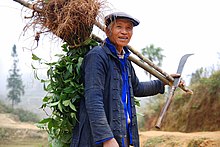User:Snoorabbits/sandbox
Agricultural practices
The Hani people have made contributions to the biodiversity of agroecosystems and mountain landscapes through their extensive traditional knowledge and maintenance of culture. [1]One of The Hani people's most known cultural practices are their cultivated terraced rice paddy. This has been a traditional practice for over 1300 years, creating a unique agroecosystem attracting both tourists and researchers.[2] The terraces are recognized as a UNESCO Heritage Site and are often cited as an incredible example of traditional farming methods.[2]
The Hani began their rice cultivation in terraced hillside fields about 1,300 years ago, when they started to form a sustainable agroecosystem made up of forests, villages, terraced rice paddies, and river systems.[2]The Hani people's rice seed bank now consists of numerous traditional rice seed varieties adapted to the cold and dry conditions of mountainous regions. In 1984, Yunnan Province, Republic of China reported "5285 rice varieties with Yuanyang County alone reporting 196 traditional varieties". [1]This is due to their innovative agricultural practices, such as integrated duck and fish farming, enhanced yield and stabilized agroecosystems. In addition, the use of green manure, such as Compositae and crofton weeds, bolstered soil health and combated pests.[1] Their water management skills have sustained the rice terraces for thousands of years by channeling water from forested mountains, without the need for reservoirs. Coupled with the region's hot and humid climate, which frequently produces thick fog, the area remains moist throughout the year.[1]This intricate farming layout, merging terraces, rivers, villages, and forests, embodies the Hani's relationship with nature. As a result, the Honghe Hani Rice Terraces were designated a World Heritage Site in 2013, emphasizing the significance of traditional knowledge in biodiversity conservation. [1]
Culture has been important in preserving the terraced landscape, especially in the face of urbanization. Unlike most farmers in China, who migrate to more developed regions for better wages, the Hani people prefer part-time non-farm jobs close to their homes, returning frequently for traditional events.[3] This employment pattern of the Hani farmers, influenced by their culture, is significant in the continued maintenance of the terraces.

Challenges still exist within this ancient farming civilization. Fewer people, especially the younger generation, are able to master the the traditional terraced farming techniques. In Aichun village, "about 600 people are between 20 and 40 years old, roughly one-fifth of the total population, but only 40 of them know the whole procedure of growing the red rice".[4] Therefore, to prevent the land from being abandoned, remaining villagers work the fields. Additionally, the local government and tourist businesses partner with farmers. Farmers lease their lands to businesses, ensuring organized land management and providing villagers with steady incomes from both lease payments and farming.[4]
- ^ a b c d e Yang, Jingbiao; Wang, Yi-Chen; Wang, Dan; Guo, Luo (2018-12). "Application of Traditional Knowledge of Hani People in Biodiversity Conservation". Sustainability. 10 (12): 4555. doi:10.3390/su10124555. ISSN 2071-1050.
{{cite journal}}: Check date values in:|date=(help)CS1 maint: unflagged free DOI (link) - ^ a b c Luo, Binsheng; Liu, Bo; Zhang, Hongzhen; Zhang, Hongkang; Li, Xuan; Ma, Lijuan; Wang, Yizhou; Bai, Yujia; Zhang, Xinbo; Li, Jianqin; Yang, Jun; Long, Chunlin (2019-11-27). "Wild edible plants collected by Hani from terraced rice paddy agroecosystem in Honghe Prefecture, Yunnan, China". Journal of Ethnobiology and Ethnomedicine. 15 (1). doi:10.1186/s13002-019-0336-x. ISSN 1746-4269.
{{cite journal}}: CS1 maint: unflagged free DOI (link) - ^ Zhang, Yongxun; Min, Qingwen; Zhang, Canqiang; He, Lulu; Zhang, Su; Yang, Lun; Tian, Mi; Xiong, Ying (2017-05-01). "Traditional culture as an important power for maintaining agricultural landscapes in cultural heritage sites: A case study of the Hani terraces". Journal of Cultural Heritage. 25: 170–179. doi:10.1016/j.culher.2016.12.002. ISSN 1296-2074.
- ^ a b 胡哲. "Millennium-old rice terraces survived in China". global.chinadaily.com.cn. Retrieved 2023-10-09.

